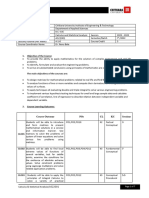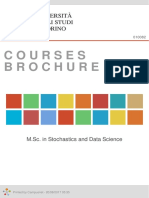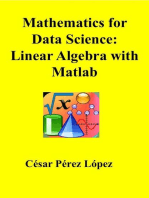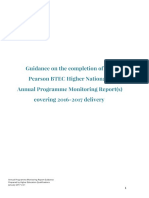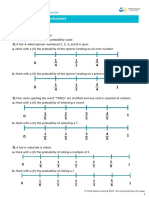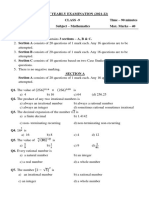Unit 2 Engineering Maths Syllabus
Uploaded by
mikeUnit 2 Engineering Maths Syllabus
Uploaded by
mikeUnit 2: Engineering Maths
Unit code M/615/1476
Unit type Core
Unit level 4
Credit value 15
Introduction
The mathematics that is delivered in this unit is that which is directly applicable to
the engineering industry, and it will help to increase students’ knowledge of the
broad underlying principles within this discipline.
The aim of this unit is to develop students’ skills in the mathematical principles and
theories that underpin the engineering curriculum. Students will be introduced to
mathematical methods and statistical techniques in order to analyse and solve
problems within an engineering context.
On successful completion of this unit students will be able to employ mathematical
methods within a variety of contextualised examples, interpret data using statistical
techniques, and use analytical and computational methods to evaluate and solve
engineering problems.
Learning Outcomes
By the end of this unit students will be able to:
1. Identify the relevance of mathematical methods to a variety of conceptualised
engineering examples.
2. Investigate applications of statistical techniques to interpret, organise and
present data by using appropriate computer software packages.
3. Use analytical and computational methods for solving problems by relating
sinusoidal wave and vector functions to their respective engineering
applications.
4. Examine how differential and integral calculus can be used to solve engineering
problems.
90 Pearson BTEC Levels 4 and 5 Higher Nationals in Engineering
Specification – Issue 5 – October 2017 © Pearson Education Limited 2017
Essential Content
LO1 Identify the relevance of mathematical methods to a variety of
conceptualised engineering examples
Mathematical concepts:
Dimensional analysis
Arithmetic and geometric progressions
Functions:
Exponential, logarithmic, circular and hyperbolic functions
LO2 Investigate applications of statistical techniques to interpret,
organise and present data, by using appropriate computer software
packages
Summary of data:
Mean and standard deviation of grouped data
Pearson’s correlation coefficient
Linear regression
Probability theory:
Binomial and normal distribution
LO3 Use analytical and computational methods for solving problems by
relating sinusoidal wave and vector functions to their respective
engineering application.
Sinusoidal waves:
Sine waves and their applications
Trigonometric and hyperbolic identities
Vector functions:
Vector notation and properties
Representing quantities in vector form
Vectors in three dimensions
Pearson BTEC Levels 4 and 5 Higher Nationals in Engineering 91
Specification – Issue 5 – October 2017 © Pearson Education Limited 2017
LO4 Examine how differential and integral calculus can be used to solve
engineering problems
Differential calculus:
Definitions and concepts
Definition of a function and of a derivative, graphical representation of a
function, notation of derivatives, limits and continuity, derivatives; rates of
change, increasing and decreasing functions and turning points
Differentiation of functions
Differentiation of functions including:
● standard functions/results
● using the chain, product and quotient rules
● second order and higher derivatives
Types of function: polynomial, logarithmic, exponential and trigonometric
(sine, cosine and tangent), inverse trigonometric and hyperbolic functions
Integral calculus:
Definite and indefinite integration
Integrating to determine area
Integration of common/standard functions and by substitution and parts
Exponential growth and decay
Types of function: algebraic including partial fractions and trigonometric
(sine, cosine and tangent) functions
Engineering problems involving calculus:
Including: stress and strain, torsion, motion, dynamic systems, oscillating
systems, force systems, heat energy and thermodynamic systems, fluid flow,
AC theory, electrical signals, information systems, transmission systems,
electrical machines, electronics
92 Pearson BTEC Levels 4 and 5 Higher Nationals in Engineering
Specification – Issue 5 – October 2017 © Pearson Education Limited 2017
Learning Outcomes and Assessment Criteria
Pass Merit Distinction
LO1 Identify the relevance of mathematical methods to a LO1 & 2
variety of conceptualised engineering examples
D1 Present
statistical data in a
P1 Apply dimensional analysis M1 Use dimensional method that can be
techniques to solve complex analysis to derive understood by a
problems equations non-technical
P2 Generate answers from audience
contextualised arithmetic and
geometric progressions
P3 Determine solutions of
equations using exponential,
trigonometric and hyperbolic
functions
LO2 Investigate applications of statistical techniques to
interpret, organise and present data by using appropriate
computer software packages
P4 Summarise data by M2 Interpret the results
calculating mean and standard of a statistical hypothesis
deviation, and simplify data into test conducted from a
graphical form given scenario
P5 Calculate probabilities within
both binomially distributed and
normally distributed random
variables
LO3 Use analytical and computational methods for solving D2 Model the
problems by relating sinusoidal wave and vector functions to combination of sine
their respective engineering application waves graphically
and analyse the
P6 Solve engineering problems M3 Use compound angle variation in results
relating to sinusoidal functions identities to separate between graphical
waves into distinct and analytical
P7 Represent engineering methods
component waves
quantities in vector form, and
use appropriate methodology to
determine engineering
parameters
Pearson BTEC Levels 4 and 5 Higher Nationals in Engineering 93
Specification – Issue 5 – October 2017 © Pearson Education Limited 2017
Pass Merit Distinction
LO4 Examine how differential and integral calculus can be D3 Analyse maxima
used to solve engineering problems and minima of
increasing and
P8 Determine rates of change M4 Formulate predictions decreasing functions
for algebraic, logarithmic and of exponential growth and using higher order
circular functions decay models using derivatives
integration methods
P9 Use integral calculus to
solve practical problems
relating to engineering
94 Pearson BTEC Levels 4 and 5 Higher Nationals in Engineering
Specification – Issue 5 – October 2017 © Pearson Education Limited 2017
Recommended Resources
Textbooks
SINGH, K. (2011) Engineering Mathematics Through Applications. 2nd Ed.
Basingstoke: Palgrave Macmillan.
STROUD, K.A. and BOOTH, D.J. (2013) Engineering Mathematics. 7th Ed.
Basingstoke: Palgrave Macmillan.
Websites
http://www.mathcentre.ac.uk/ Maths Centre
(Tutorials)
http://www.mathtutor.ac.uk/ Maths Tutor
(Tutorials)
Links
This unit links to the following related units:
Unit 39: Further Mathematics
Pearson BTEC Levels 4 and 5 Higher Nationals in Engineering 95
Specification – Issue 5 – October 2017 © Pearson Education Limited 2017
You might also like
- Unit 2 - Engineering Mathematics Assignment 2 2024No ratings yetUnit 2 - Engineering Mathematics Assignment 2 20249 pages
- Unit 26 Mathematics For IT PractitionersNo ratings yetUnit 26 Mathematics For IT Practitioners8 pages
- Mathematics Course Code: 4300001: Page 1 of 10No ratings yetMathematics Course Code: 4300001: Page 1 of 1010 pages
- Unit 2 - Scientific Data Handiling AB 2022 - 23No ratings yetUnit 2 - Scientific Data Handiling AB 2022 - 235 pages
- Attachment Circular 2023081114090722 As 001No ratings yetAttachment Circular 2023081114090722 As 0017 pages
- Unit 4 Mathematics For Engineering TechniciansNo ratings yetUnit 4 Mathematics For Engineering Technicians15 pages
- Introduction to Advanced Engineering MathematicsNo ratings yetIntroduction to Advanced Engineering Mathematics3 pages
- Numerical Analysis For Materials MScE3108 Course Outline 2015E CNo ratings yetNumerical Analysis For Materials MScE3108 Course Outline 2015E C8 pages
- 295468-chemistry-mathematical-skills-handbookNo ratings yet295468-chemistry-mathematical-skills-handbook49 pages
- Unit 4 Mathematics For Engineering TechniciansNo ratings yetUnit 4 Mathematics For Engineering Technicians15 pages
- Unit 1 Optimization &numerical Techniques 1No ratings yetUnit 1 Optimization &numerical Techniques 1111 pages
- C - Documents and Settings - Administrator - Local Settings - Application Data - Mozilla - Firefox - Profiles - GhcvulkxNo ratings yetC - Documents and Settings - Administrator - Local Settings - Application Data - Mozilla - Firefox - Profiles - Ghcvulkx13 pages
- Stage 2 Essential and General Mathematics - Implementation Workshop Booklet100% (1)Stage 2 Essential and General Mathematics - Implementation Workshop Booklet79 pages
- 405 M.E. Computer Science and EngineeringNo ratings yet405 M.E. Computer Science and Engineering68 pages
- Unit 2 Mathematics For Engineering TechniciansNo ratings yetUnit 2 Mathematics For Engineering Technicians8 pages
- Unit 103 Further Mathematics For Engineering TechniciansNo ratings yetUnit 103 Further Mathematics For Engineering Technicians13 pages
- Autonomous Programmes Bachelor of Engineering Department of Computer Science and EngineeringNo ratings yetAutonomous Programmes Bachelor of Engineering Department of Computer Science and Engineering28 pages
- Assignment Brief Course No.:: 010303100: Functional MathematicsNo ratings yetAssignment Brief Course No.:: 010303100: Functional Mathematics10 pages
- Engineering Admissions Assessment (Engaa) Content SpecificationNo ratings yetEngineering Admissions Assessment (Engaa) Content Specification40 pages
- Modelling Success in Information Technology ProjectsNo ratings yetModelling Success in Information Technology Projects4 pages
- GED102-Use of Mathematics in Different Engineering CoursesNo ratings yetGED102-Use of Mathematics in Different Engineering Courses3 pages
- AR 20 - ME - I To IV SEM 11-12-2021 FINALNo ratings yetAR 20 - ME - I To IV SEM 11-12-2021 FINAL140 pages
- Fourier Series: Fourier Series For Continuous & Discontinuous Functions, Expansion ofNo ratings yetFourier Series: Fourier Series For Continuous & Discontinuous Functions, Expansion of17 pages
- Unit 2: Engineering Maths: Unit Code M/615/1476 Unit Type Core Unit Level 4 Credit Value 15No ratings yetUnit 2: Engineering Maths: Unit Code M/615/1476 Unit Type Core Unit Level 4 Credit Value 151 page
- Blended Learning Using HN Online: A Guide For Teaching TeamsNo ratings yetBlended Learning Using HN Online: A Guide For Teaching Teams7 pages
- Degrees Please Enter Subject or Uni SearchNo ratings yetDegrees Please Enter Subject or Uni Search21 pages
- Article On How To Write 1st Class Dissertation ProposalNo ratings yetArticle On How To Write 1st Class Dissertation Proposal8 pages
- Assessment Planning - BTEC Higher NationalsNo ratings yetAssessment Planning - BTEC Higher Nationals1 page
- Pearson BTEC Level 2 and Level 3 Structure Updated PDFNo ratings yetPearson BTEC Level 2 and Level 3 Structure Updated PDF1 page
- Unit 14 Structural Mechanics in Construction and Civil EngineeringNo ratings yetUnit 14 Structural Mechanics in Construction and Civil Engineering14 pages
- Mathematics: Quarter 2 - Module 3: The Relations Among Chords, Arcs, Central Angles and Inscribed Angles100% (1)Mathematics: Quarter 2 - Module 3: The Relations Among Chords, Arcs, Central Angles and Inscribed Angles25 pages
- Third Space Learning Sample Space GCSE WorksheetNo ratings yetThird Space Learning Sample Space GCSE Worksheet15 pages
- Applied Econometric Time Series 3Rd Ed.: Chapter 3: Modeling VolatilityNo ratings yetApplied Econometric Time Series 3Rd Ed.: Chapter 3: Modeling Volatility80 pages
- You Want To Compare The Present Value of $1000 Yearly For 13 Years With $10 000 Now. So You Want To Calculate The Present Value of An AnnuityNo ratings yetYou Want To Compare The Present Value of $1000 Yearly For 13 Years With $10 000 Now. So You Want To Calculate The Present Value of An Annuity5 pages
- B.A. (Prog..) Mathematics 2nd Semester-2023No ratings yetB.A. (Prog..) Mathematics 2nd Semester-20238 pages
- APPENDIX A - Introduction To MATLAB PDFNo ratings yetAPPENDIX A - Introduction To MATLAB PDF13 pages
- 1978 Marek 553-ProbAnalysis-PlaneShearFailureNo ratings yet1978 Marek 553-ProbAnalysis-PlaneShearFailure5 pages
- Problem 1 Problem 8:: Dy DX y 3e - 5 2 e + 8 LN 5x100% (1)Problem 1 Problem 8:: Dy DX y 3e - 5 2 e + 8 LN 5x6 pages
- Unit 2 - Engineering Mathematics Assignment 2 2024Unit 2 - Engineering Mathematics Assignment 2 2024
- Numerical Analysis For Materials MScE3108 Course Outline 2015E CNumerical Analysis For Materials MScE3108 Course Outline 2015E C
- C - Documents and Settings - Administrator - Local Settings - Application Data - Mozilla - Firefox - Profiles - GhcvulkxC - Documents and Settings - Administrator - Local Settings - Application Data - Mozilla - Firefox - Profiles - Ghcvulkx
- Stage 2 Essential and General Mathematics - Implementation Workshop BookletStage 2 Essential and General Mathematics - Implementation Workshop Booklet
- Unit 103 Further Mathematics For Engineering TechniciansUnit 103 Further Mathematics For Engineering Technicians
- Autonomous Programmes Bachelor of Engineering Department of Computer Science and EngineeringAutonomous Programmes Bachelor of Engineering Department of Computer Science and Engineering
- Assignment Brief Course No.:: 010303100: Functional MathematicsAssignment Brief Course No.:: 010303100: Functional Mathematics
- Engineering Admissions Assessment (Engaa) Content SpecificationEngineering Admissions Assessment (Engaa) Content Specification
- Modelling Success in Information Technology ProjectsModelling Success in Information Technology Projects
- GED102-Use of Mathematics in Different Engineering CoursesGED102-Use of Mathematics in Different Engineering Courses
- Fourier Series: Fourier Series For Continuous & Discontinuous Functions, Expansion ofFourier Series: Fourier Series For Continuous & Discontinuous Functions, Expansion of
- Unit 2: Engineering Maths: Unit Code M/615/1476 Unit Type Core Unit Level 4 Credit Value 15Unit 2: Engineering Maths: Unit Code M/615/1476 Unit Type Core Unit Level 4 Credit Value 15
- Mathematics for Data Science: Linear Algebra with MatlabFrom EverandMathematics for Data Science: Linear Algebra with Matlab
- Blended Learning Using HN Online: A Guide For Teaching TeamsBlended Learning Using HN Online: A Guide For Teaching Teams
- Article On How To Write 1st Class Dissertation ProposalArticle On How To Write 1st Class Dissertation Proposal
- Pearson BTEC Level 2 and Level 3 Structure Updated PDFPearson BTEC Level 2 and Level 3 Structure Updated PDF
- Unit 14 Structural Mechanics in Construction and Civil EngineeringUnit 14 Structural Mechanics in Construction and Civil Engineering
- Mathematics: Quarter 2 - Module 3: The Relations Among Chords, Arcs, Central Angles and Inscribed AnglesMathematics: Quarter 2 - Module 3: The Relations Among Chords, Arcs, Central Angles and Inscribed Angles
- Applied Econometric Time Series 3Rd Ed.: Chapter 3: Modeling VolatilityApplied Econometric Time Series 3Rd Ed.: Chapter 3: Modeling Volatility
- You Want To Compare The Present Value of $1000 Yearly For 13 Years With $10 000 Now. So You Want To Calculate The Present Value of An AnnuityYou Want To Compare The Present Value of $1000 Yearly For 13 Years With $10 000 Now. So You Want To Calculate The Present Value of An Annuity
- Problem 1 Problem 8:: Dy DX y 3e - 5 2 e + 8 LN 5xProblem 1 Problem 8:: Dy DX y 3e - 5 2 e + 8 LN 5x




























